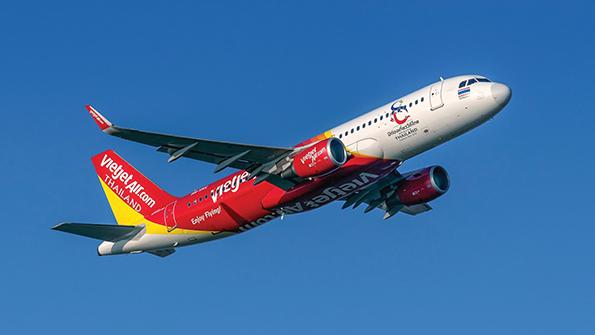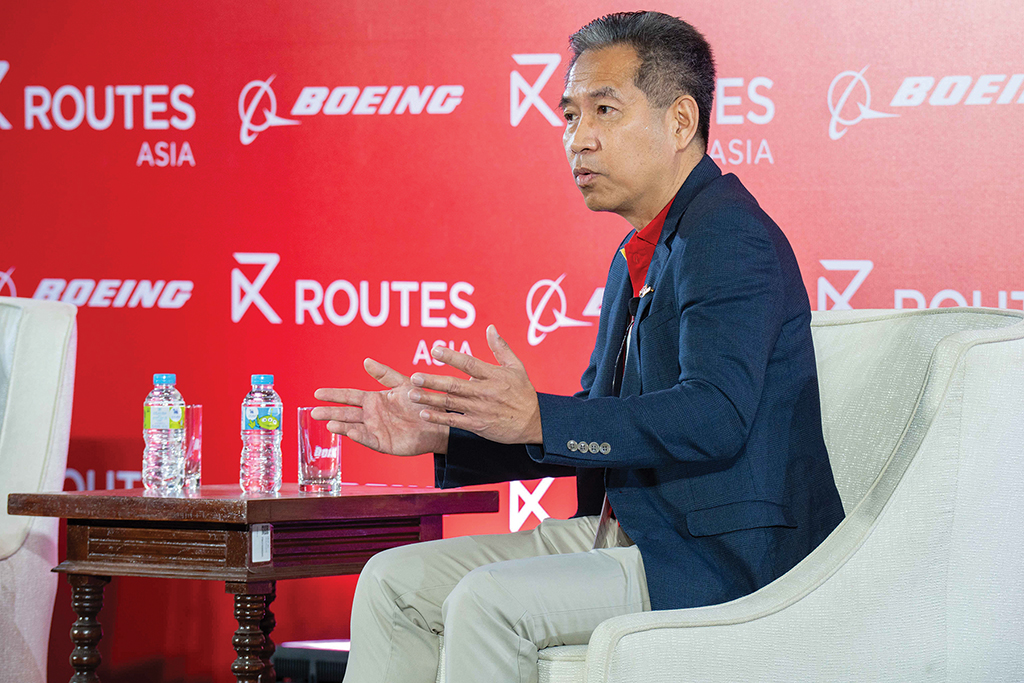
Thai Vietjet currently operates 18 Airbus A320 family aircraft but will transition to an all-Boeing 737 MAX fleet beginning in 2024.
Thai Vietjet CEO Woranate Laprabang joined the LCC in July 2020, having previously served at Thai Airways, where he helped set up subsidiary Thai Smile. The carrier is preparing to receive the first of 50 Boeing 737 MAX 8s in July 2024 as it seeks to ramp up the number of international destinations served.
– Interview by DAVID CASEY
You joined the business during a time of strict lockdowns. How did you reposition the airline so it was able to accelerate its growth as markets reopened? Thai Vietjet operated a lot of charter flights into China before the pandemic. But the closure of international operations meant we had to look domestically—that led us to open six new destinations within five months. We successfully increased our share from the sixth largest domestic operator in Thailand to the second. I don’t think we would have been able to do this during “normal” times, but the crisis created opportunities. When other airlines stepped back, we pushed ahead at full steam. When I joined the business, we had 650 staff and 11 aircraft—now it is closer to 1,000 staff and 18 aircraft. We are a small airline at the moment, but we have lots of room to grow. Our ambition is to grow the fleet to 50 aircraft by 2027.

Thai Vietjet is an associate company of Vietnamese airline Vietjet. How does the relationship work? The Vietnamese business holds a minority share in Thai Vietjet. We share the same booking system, and they support us in terms of aircraft. Most of the aircraft we operate are subleased from Vietjet, while we work together closely in terms of sales and marketing. Another positive is that Vietjet already has good brand recognition because they have been operating for longer than us, which is great when we’re looking to enter new markets.
Can you tell us more about the fleet expansion plans and what it will mean for Thai Vietjet? We have 18 Airbus aircraft—12 A320s and six A321s—and we may take delivery of a few aircraft this year. But 2024 will mark a big change for Thai Vietjet as we plan to take 50 Boeing 737 MAX jets over a three-year period. It will take three or four years to transition completely from Airbus to Boeing, but it will make us more competitive as an airline in the long run. Our fuel consumption using the MAX will be about 15% lower and maintenance costs will be reduced significantly during the first few years of operation.
How do you see your network changing? We’ve shifted from a charter airline before the pandemic to a domestic airline now, and we’ll become an international airline within the next few years. About 99% of our capacity was domestic in January 2022 and it is about 75% today. By the end of 2023, we expect international to be about 35% of our business and by the end of our five-year plan, it will be about 85%. We’re going to grow in Indochina, North Asia, India and China. The MAX will also open new network opportunities, allowing us to fly longer routes than we’re able to with the A320 and A321. It will enable us to reach destinations in the north of Japan or Perth in Australia. At the moment, we don’t have any plans to take widebodies to operate flights into Europe, for example, as we still see lots of growth opportunities in this region that we can capture.
What are the biggest challenges you’re facing at the present time? Thailand is an attractive tourist destination and I think 2023 will be a good year for everyone. The demand is there—people still need to travel and want to travel. We’re seeing markets in Europe coming back strongly and expect to see more and more Chinese tourists return. But there are still some obstacles that airlines need to manage. First is capacity, as demand is outstripping supply. Boeing and Airbus have large backlogs, while aircraft in the secondary market are being leased very quickly. Inflation will also be a factor as it impacts the money in the pocket of the people who can travel and is pushing up costs for everyone, including airlines and suppliers.
How can Thai Vietjet keep costs competitive given the high inflation and fuel prices? Maintaining our low costs is key in this market. We’re building a cost-conscious culture within the organization so that everyone is aware that in order to survive in this low-margin business, we need to make sure that we have a good productivity, good efficiency and are competitive on costs at all times. We’re also looking to increase revenue per aircraft and reduce our unit costs. Our average stage length was only 1 hour last year and as of today it is about 1.3. By the end of the year, it will be about 1.6 and in five years it will be about 2.5 hours per sector. Our aircraft utilization will also rise from about 8.5 hours per day in 2022 to around 12.5 hours per day once China fully reopens.





